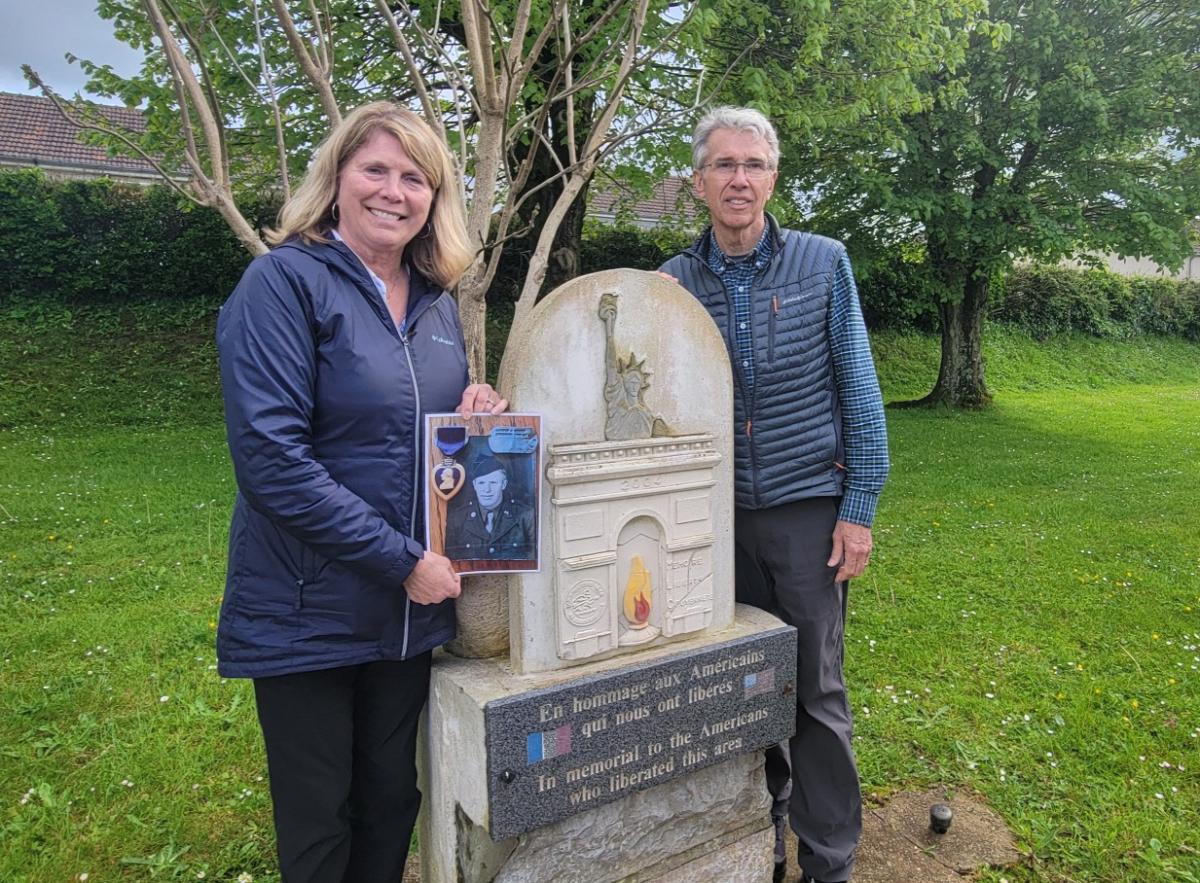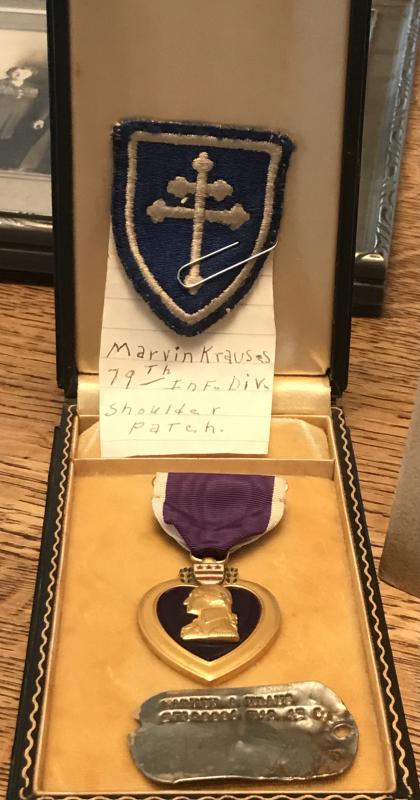Recently Mark and LuAnn Urlaub took a trip to honor LuAnn’s uncle, an uncle she never met. "Mark and I wanted to learn more about my Uncle Marvin A. Kraus' service and see the places that Dad spoke of." Marvin's brother, LuAnn's father, entered the Army after Marvin's death so the two men's mother did not have an easy go of it during World War II.
To find out a little bit more about her uncle Marvin's experience, the couple the couple signed up for a WW2 history tour that included England and France (Normandy and Paris)
Utah Beach was Marvin’s point of entry during World War II. "Looking up and down the beach I tried to imagine what it was like. The best I could do was collect sand to bring home," LuAnn said. "At Utah Beach, there is a building named the Le Roosevelt. In 1944 it was a bunker occupied by the Germans. The building still stands and is now a souvenir shop and a small restaurant. As many family members of servicemen have done, I signed a message on the wall, a message in honor of Marvin and the date he was KIA," she said and added, "I had tears."
Arriving at about the same time of the year as Marvin had back in 1944. The roads in Normandy are small and winding. The roads are now paved but in 1944 there was mud.
The couple hired a guide over the internet to take them on a very specific day-long private tour. The two said that they were not disappointed. Their guide Romain was fluent in English and had done his research. "Romain was personally interested in the 79th Division," where Marvin had served. The couple had emailed him information in advance which included a photo of Marvin, that he was glad to have received. The couple asked their guide, Romain, what he'd be doing after they left. He stated that he was leading a group from the US and their leader was David Eisenhower, none other than the grandson of President Eisenhower! They knew then that they had gotten one of the best.
Marvin arrived in Normandy on D-Day + 8 (June 14. 1944). Arriving from Clayton County, Iowa this World War II, Army Soldier was a Private First Class.
His family at first only knew from his letters that he was “somewhere in England” or “somewhere in France.” Marvin’s faith was strong and he regularly would reassure his mother in his letters home that he was attending services and reading the Service Testament adding "What more can I do?" Even in his last letter home, written on July 2, he writes a lot about prayer and scripture and that “with God’s help I’m doing the best I can”. LuAnn said, "I’m personally grateful for Grandma’s insistence on faith in her family’s life as what else does one hold to when faced with death in a foxhole? Grandma Kraus was very insistent that religion be held in a place of highest honor in their home growing up."
The motto, "Loose lips sink ships" was taken seriously. In correspondence home, he could tell the family very little of his whereabouts or anything that the soldier knew concerning the mission he was on. The letters from overseas were called V--Mail, Marvin’s were usually general and personal in nature, and nothing was ever blacked out.
Unfortunately, Marvin sometimes felt like he had been abandoned by his family. While his letters made it home, the postal service didn't deliver mail to his unit in a timely manner pushing him to ask why no one was writing. In those days and times, it would have been impossible to track soldiers down in a timely manner.
In a letter dated June 30, he wrote, “I suppose you have been wondering where I have been. I am located someplace in France. I have also been in the battle for Cherbourg. It was plenty tough at times. But all a person can do is keep praying and have faith in God and I think He will take care of us.” He also said, “Gee, don’t you folks ever write? I’ll have to raise a little Cain. But I suppose you think the same of me.”
His last letter was written, from his foxhole on July 2. He apologized for not sending a Father’s Day gift and said things were a little hard to get and send. "We know that the very next day the attack would begin to take Hill 84 near Montgardon," LuAnn said. His mother has written on the outside of the envelope “My last letter from my son.”
LuAnn, the keeper of this story and memorabilia for her uncle Marvin, has several of
these letters saved for generations to read and remember. Among those letters from France was a final dispatch from the Army notifying the family of Marvin's death.
Pfc Marvin A Kraus entered military service at age 30 on June 9, 1942. He was sent to Camp Pickett in Virginia, and assigned to the 79th Infantry Division. The 79th was reactivated at Camp Pickett on June 15th, 1944 after being de-activated at the end of WW1, where it had significant involvement.
As a soldier in the 315th Regiment of the 79th Infantry Division, Marvin trained in five camps for 22 months in activities and the environment that soldiers would encounter in Europe.
Before shipping out for the war, Marvin had leave time at home. It was then that he was photographed in his uniform and a family photo was taken with his parents and all four sons. Before he left, he had a feeling that he wouldn't make it home and told his brother Eugene (LuAnn's Dad).
He sailed from Camp Miles Standish, Massachusetts aboard the RMS Queen Mary, a requisitioned luxury-liner-turned-troopship to Liverpool, England landing on April 17,1944. Then he entered more training to be used in the Normandy invasion. His point of departure for France was from the Port of Southampton.
The 79th infantry, in Higgins boats, made a nighttime 7-hour trip across the English Channel. The overnight trip was cold, and upon arrival the soldiers jumped out into 3.5 feet of water. They started cold and wet as did the men on D-Day.
The mission of the 79th was to land on Utah Beach on June 14 (D-Day+8) and to capture the port of Cherbourg which had been occupied and controlled since June 17, 1940, by the Germans. Utah Beach was still ‘hot’ with German holdouts still shelling and bombing the Americans as they landed with dangerous, intermittent gunfire. The first casualty of the 79th was in the 315th and happened when a soldier, still on a landing craft, took a piece of shrapnel. Utah Beach was busy with soldiers, vehicles, and supplies being delivered and with the above ‘fire’ it was a dangerous place despite the fact that the beaches belonged to the Allies.
On June 19, the 313th, 314th and the 315th moved north to Cherbourg. (Refer to “The Race to the Rhine: How the US 79th Division Took Down the Nazis” for specifics on the troop movements.)
The terrain they encountered was hilly at first but then they moved into flat land with marshes and hedgerows. Hedgerows still exist and are tall rows of mounded earth covered with thick vegetation and stone. Most are centuries old. The Germans placed artillery and concrete pillboxes within the hedgerows. Progress was measured by hedgerows.
Tanks were unable to push through hedgerows, so they modified the tanks (on the spot) to equip them with a bulldozer-type attachment, called tank dozers. Americans didn’t know if Germans were on the other side, often they were.
After the capture of Cherbourg, regiments moved southward in the Carentan Peninsula. They faced German troops who were now battle-hardened and committed, not just conscripted soldiers from Nazi occupied countries. At the end of June and into early July, the 79th was moving toward Montgardon and La Haye du Puits. It was necessary to capture both villages with the 79th mission to create a line across the peninsula to prevent Germans from retaking the Cherbourg port. The ultimate goal of liberating La Haye du Puits was necessary to take a series of five hills.
“Hill 84” was particularly difficult and was called “Bloody Hill,” by the Germans. On this hill there were many injuries and deaths. It was a 5-day battle. July 5, about 2 miles outside of the village of Montgardon, in heavy battle, Marvin sustained bodily injury to the abdomen and was killed in action, information from the war department stated with "bullet/missile/mortar."
One account says, “Once again the GIs in the division faced a tenacious, desperate enemy holding the hedgerows and contesting all the roads leading south. Ubiquitous 88mm artillery pieces were augmented by dug-in panzers and deadly snipers. At zero hour, 5:30 a.m. on July 3, the regiments set out in a cold drizzle toward their objectives…"
On July 5, the 315th encountered for the first time "the vaunted troops of the 2nd Schutzstaffel (SS).” On this day, the 315th and 313th took Hill 84, “Bloody Hill.” The tour guide leading the Urlaubs on their tour thought it likely that it was towards the end of the day that Marvin gave his life for freedom. From there the 79th was able to liberate La Haye du Puits where today there is a monument paying tribute to this division.
Their guide took them to the overlook where five hills were seen. These hills were the places of vicious battles, particularly Hill 84. "Using his research material and the daily battle logs of the 79th, LuAnn said, "Romain took us to a large meadow outside of the village of Montgardon, where he is relatively certain Marvin fought his last battle. We stood in silent reverence as we pondered what we were just told. We recorded Romain’s words and took pictures. I was saddened once again by Marvin’s loss and our family’s loss but I also had a sense of pride that my uncle fought in the battle against evil to help liberate France and the world. It is a very profound feeling to stand on the ground where my family’s blood was shed for the cause of freedom."
Marvin’s body was laid to rest in a temporary cemetery at Blosville. This was one of the first temporary cemeteries started in France and was intended for casualties of the 82nd Airborne, but it soon began to meet the needs of other units. The field eventually held 6,000 men. There were no caskets but only body bags for burial. At the time, paratroopers that were killed were sometimes buried in their parachutes if they were available.
Each serviceman had 2 dog tags. One was removed and given to the commander for the purpose of notification of family and then given to the family. The other tag remained with the soldier, often placed in the mouth as the mandible is one of the hardest bones and slower to decompose. Fortunately, the cemetery was mapped out and each soldier had a row, plot and grave assignment carefully recorded.
One of the things that touched LuAnn the most was that the memory is being kept alive in Normandy. "I am grateful for the memorial and signage that remembered this place of temporary eternal rest of the liberators," she said. "There are memorials scattered all over Normandy recounting the heroism and liberation by the Allies, including the Americans. They have not forgotten the sacrifices. The museums are top notch and so worth seeing. We needed more time," she added. "There is a memorial in Montgardon to the liberating Americans, which includes Marvin."
LuAnn's grandparents were notified of Marvin’s death in a Western Union telegram from the Adjutant General (Ulio) dated August 4, 1944 and it reads: “THE SECRETARY OF WAR DESIRES ME TO EXPRESS HIS DEEP REGRET THAT YOUR SON PRIVATE FIRST CLASS MARVIN A. KRAUS WAS KILLED IN ACTION ON FIVE JULY IN FRANCE. LETTER FOLLOWS." The telegram was received by the Western Union agent in Elkader, who personally delivered it. LuAnn said that when her Dad saw the agent drive into the farmyard, he knew it meant bad news.
Meanwhile across the ocean, older French men from the villages came to dig graves, and captured Germans were also made to dig graves. Wooden crosses were constructed, and the soldier’s name and service number were stenciled on them. Women from nearby villages came regularly to tend to these graves and brought flowers.
LuAnn said that her grandparents later received a letter from the war department stating the name of the cemetery with the burial site details: “U.S. Military Cemetery, Blosville, France, plot G, row 8, grave 153.” The letter assured them that the grave was “under the constant care and supervision of United States military personnel.”
Other letters followed filling a large notebook with memorabilia. Something not in the notebook is a poster sized note from President Roosevelt expressing his sympathy, this piece has been framed.
The notebooks show the amount of paperwork that came to the family following Marvin’s death. Paperwork about life insurance, the death benefit from the government, Gold Star registration with the Iowa State Department of History and Archives, and of course the decision where to bury him and the details of his funeral. LuAnn said of her grandparents, "It must have seemed like they were receiving that Western Union telegram over and over, each time paperwork arrived needing their attention."
In September of 1947, Marvin's parents were given a series of four options for Marvin. He could remain where he was, he could be returned to the states to be buried in a national cemetery, he could be placed in a permanent American military cemetery overseas which would have been in the American Cemetery overlooking Omaha Beach.
The family chose the remaining option for Marvin to be returned to the United States, to be next to kin in a private cemetery.
Marvin was posthumously awarded the Purple Heart and his name is engraved on it. No personal effects were returned except a Cross of Lorraine shoulder patch from his uniform.
Marvin arrived home In May of 1948, accompanied by a uniformed soldier. A funeral was held at his home church, St. Paul Evangelical Lutheran Church in Garnavillo and he was laid to rest at the Ceres Cemetery.
LuAnn's Grandpa began helping to dig graves at the Ceres Cemetery a few years earlier, but a friend stepped up to take his place so that he didn’t have to dig his own son’s grave.
As the Urlaubs toured the area of their uncle's last tour, they were shown the room where Lt. General von Schlieben surrendered Cherbourg to General Collins. Just outside the wall of the chateau a memorial stands to honor a Dominic Ternan, Chaplain of the 315th who was shot on June 19 by a sniper and killed on a small bridge right as he administered last rights to a soldier. He was in rain gear, and it is surmised that his chaplain’s identifiers could not be seen as it was not usual for chaplains to be intentionally targeted. LuAnn said, "Our guide asked if my uncle had been a religious man and when I said that he was, he that he likely would have known this chaplain."
Marvin wasn't forgotten for decades later. Near the July 5th date his brother would commemorate his life and service with flowers brought to the church. The large flag that draped his coffin was donated to the American Legion post to be flown in the Garnavillo City Park's Avenue of Flags along with his brother's.
While this trip was specifically to get more answers about her uncle, her father also served at the same time. LuAnn summed up her feelings about her family's service well. "I am grateful and proud of Marvin’s and Dad’s service. I am grateful for all who have served our great nation in any capacity. We must continue to tell these stories of American heroes to every generation and take nothing for granted. This type of heroism defines us as a nation. We must never forget. I am grateful to have made this journey."
On this, the 80th Anniversary of D-Day, we pause to remember Marvin A. Kraus and all those who were lost during World War II specifically and with heartfelt appreciation, we again say, "Thank you."















Comments
Submit a CommentPlease refresh the page to leave Comment.
Still seeing this message? Press Ctrl + F5 to do a "Hard Refresh".